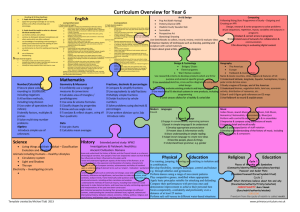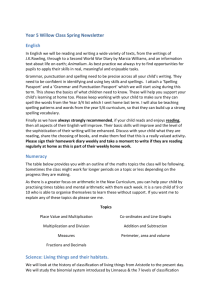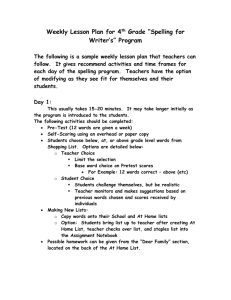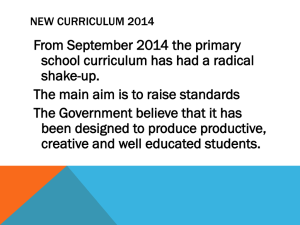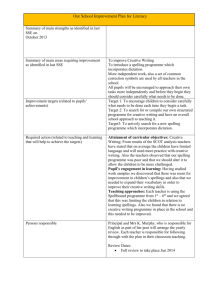Research in the classroom: intervention on teaching the o/e a/e rule
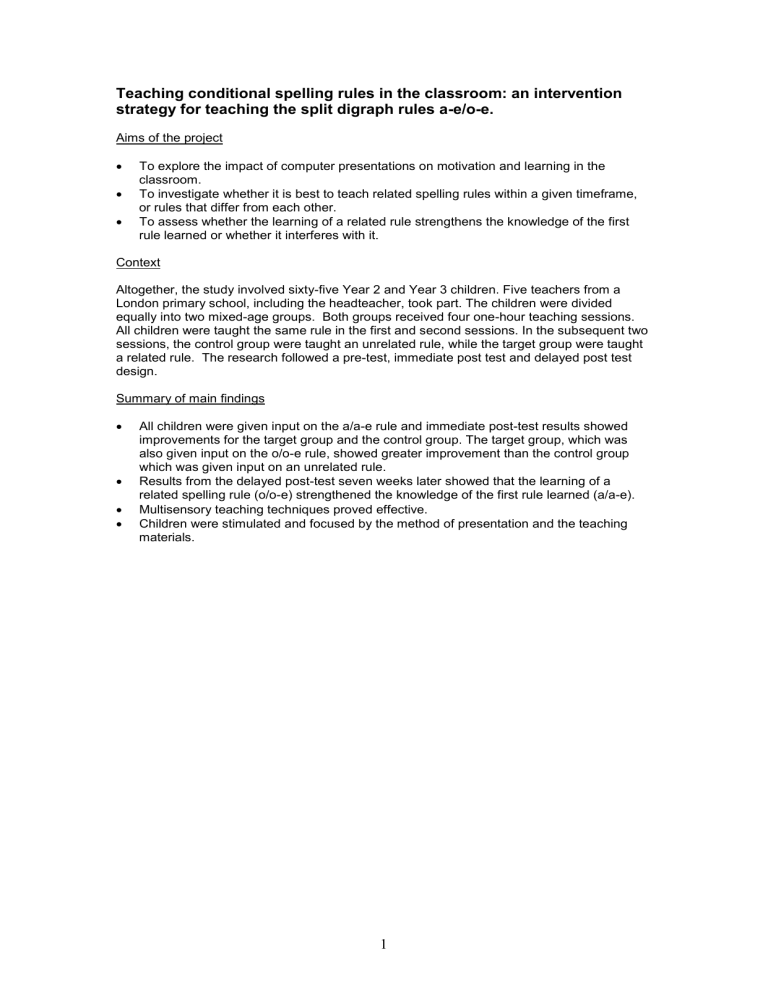
Teaching conditional spelling rules in the classroom: an intervention strategy for teaching the split digraph rules a-e/o-e.
Aims of the project
To explore the impact of computer presentations on motivation and learning in the classroom.
To investigate whether it is best to teach related spelling rules within a given timeframe, or rules that differ from each other.
To assess whether the learning of a related rule strengthens the knowledge of the first rule learned or whether it interferes with it.
Context
Altogether, the study involved sixty-five Year 2 and Year 3 children. Five teachers from a
London primary school, including the headteacher, took part. The children were divided equally into two mixed-age groups. Both groups received four one-hour teaching sessions.
All children were taught the same rule in the first and second sessions. In the subsequent two sessions, the control group were taught an unrelated rule, while the target group were taught a related rule. The research followed a pre-test, immediate post test and delayed post test design.
Summary of main findings
All children were given input on the a/a-e rule and immediate post-test results showed improvements for the target group and the control group. The target group, which was also given input on the o/o-e rule, showed greater improvement than the control group which was given input on an unrelated rule.
Results from the delayed post-test seven weeks later showed that the learning of a related spelling rule (o/o-e) strengthened the knowledge of the first rule learned (a/a-e).
Multisensory teaching techniques proved effective.
Children were stimulated and focused by the method of presentation and the teaching materials.
1
Background
For a number of years our school has had a close relationship with Professor Terezinha
Nunes and Dr Ursula Pretzlik (Oxford Brookes University) and Professor Peter Bryant
(University of Oxford). Members of the research team were interested in the way in which children acquire an understanding of the written language system and wanted to carry out an assessment of a brief intervention programme to teach related spelling rules rather than unconnected rules. We wanted to find a format that would fit satisfactorily into the Literacy
Hour. The multisensory tasks we chose had previously been used successfully with individual pupils in a research setting.
Lauriston primary school is a one form entry, inner-city primary school with 260 pupils aged 3
- 11 on roll. It is a Beacon school situated in East London. The Year 3 class had twenty boys and twelve girls. Eighteen children in the year group were on the SEN Profiling System, one of whom had a full statement. The Year 2 class had sixteen boys and seventeen girls.
Fourteen of these children were on the Profiling System.
Teaching processes and strategies
We used PowerPoint computer presentations which featured moving, talking puppets to teach three basic spelling rules. Intervention Group 1 were taught the related rules a/a-e (hat/hate) and o/o-e (hop/hope). These rules are related and based on phonology; the split digraph where the final ‘e’ influences the pronunciation of the preceding vowel. Intervention Group 2 were taught unrelated rules. In the first two sessions they were taught the a/a-e rule and in the subsequent two sessions they were taught the k/ck (look/lock) rule which is based on the number of letters after the first vowel in the syllable. In total the intervention consisted of four
60 minute sessions spread over two weeks.
All the children sat at tables facing the screen. The PowerPoint presentations were projected onto the screen using a data projector. With each rule the children were presented with 40 words per session. Each word was presented by one of two puppets – a dinosaur and a boy.
The first slide showed the puppet saying the word. The second slide was shown whilst the child had to make a decision about the word’s spelling. Finally the third slide was shown and the correct answer came up on the screen.
The 40 words for each rule were divided into 4 blocks of 10 words. There were two types of block, and these alternated. In one the children were asked to make a simple judgement about whether or not the word should be spelled with a final e, or in the case of the k/ck rule whether the word should end in a k or a ck. In the second type of block the children were asked to spell the whole word each time; they had to write the word on their sheets before they were given feedback about how the word was spelled. The transition from one block to th e other was clearly signalled by the puppets announcing that the children had finished ‘one level’ and were ready to go onto the next level.
As we were using the task with the whole class, we needed to find a way of giving all the children a chance to produce an answer in the first part of the task, where they had to make a judgement and did not have to produce a spelling. We solved this problem by developing a code with the children: they had to put up a gold card with a red spot for one type of response and a blank gold card for the other type. The gold side of the cards was presented to the teacher, while the sides seen by the other children were white. On the white side, we had written (very faintly) the relevant letters, for example a or a-e. In this way it was very easy for the teacher to keep track of whether the children were giving correct responses, but it was not easy for the children to look at others and imitate their responses. Thus they had to think for themselves.
Findings
A comparison of pre and immediate post-test results showed that learning the o/o-e rule directly after the a/a-e rule reinforced the mastery of the a/a-e rule because of the connection between the two rules. Although the two groups had the same amount of experience with the
2
a/a-e rule, the group that learned the related rule (Group 1) made more progress than the control group (Group 2). The delayed post-test, which took place seven weeks later, showed a clear gain for Group 1. Mastery of the a/a-e rule was more firmly established among the children in Group 1 than among the children who made up Group 2. (See graph)
a/a-e real words and pseudowords
Post-test F=3.49; p= .071
Delayed post-test F=3.27; p< .084
15
10
5
0 post-test delayed post-test related rules unreleated rules
0 = baseline established at pre-test
The multisensory teaching techniques were very effective. These techniques have been an essential part of the practice of specialist teachers for many years. Their regular use in whole class teaching is a more recent phenomenon. In the intervention sessions we employed visual, auditory and kinaesthetic approaches. The PowerPoint presentations were visually stimulating and engaged the children’s attention, enabling them to concentrate for extended periods on tasks requiring careful listening and close attention to letter order. The aural and written sections of the activities had kinaesthetic elements, for example, through pupils being asked to select cards to represent sounds or write words. This kinaesthetic reinforcement involved the learners in the learning task and appears to have been an important means of reinforcing learning and triggering recall.
The puppets used in the PowerPoint presentations had an immediate appeal for the children.
Pupils were encouraged to put the kind of effort into their learning that has a real impact on achievement as the following quotations from pupils illustrate.
“I liked the a-e and a game with the puppets. I found it a little bit hard, but I still tried my hardest…… The nonsense words were a little bit hard, so I listened hard, really hard.”
“I think learning from the puppets was much better than learning from the teachers. Because we learnt from the puppets I think I’m going to remember it for much longer than if the teacher had taught us.”
The nature of the tasks was such that they appealed to the competitive pupils, but, as study of the videos showed, did not appear to threaten the less confident learners.
Research methods
We used an experimental design with pre-test, immediate post-test and delayed post-test.
The test materials were provided by Nunes and Bryant.
3
In the first part of the assessment children had to spell, as well as they could, a list of 36 fairly common words, which were embedded in meaningful sentences. In the second part, they had to spell a list of what are called pseudo-words. There were 36 pseudo-words, like nad, dobe and crisk that had no meaning but can be spelled according to the spelling rules that we were interested in. The pseudo-words were also embedded in meaningful sentences.
The reason for including these pseudo-words was to make sure that children were genuinely using rules rather than just remembering the spelling of specific words, like hope, without understanding the underlying rule for words of this sort. This kind of rote remembering is simply impossible in the case of pseudo-words since these will be completely unfamiliar to any of the children. That is why they are an essential test of rule learning.
For the intervention the children were divided into two groups randomised by taking alternate names from the age ordered registers. Group 1 formed the target group working on related rules and Group 2, the control group, working on unrelated rules.
Both groups of children were taught in the same manner and classroom layout and equipment was similar. Teaching sessions for both groups were held at the same time, lessons were scripted to ensure that the work was presented in the same manner and video recordings of the sessions were made. The first two sessions were identical for both groups. In the subsequent two sessions the content alone varied. Group 2 thus became the control group for
Group 1.
Video recording of intervention sessions helped teacher/researchers to observe children, monitor their teaching and enabled them to share good practice with colleagues. Some pupils kept research diaries to help them reflect on their learning. The diaries also gave the researchers insight into the children’s thinking and feedback on the impact of the presentation methods. In taped interviews, some pupils were asked to draw out and make explicit the rules they had been taught. These interviews contributed to the evaluation the quality of the learning that had taken place.
Conclusion
It can be concluded that this type of child-focused intervention, which has previously been shown to be effective in one-to-one situations, is transf erable from the psychologists’ experimental setting to the teachers’ classroom environment.
Computer presentations combined with other multisensory teaching techniques were a practical and effective means of delivering teaching to a large group of children. By dividing each taught session into two it would be possible to use these sessions in the Literacy Hour.
It should also be possible to transfer these techniques to other whole class ‘word and sentence level’ work in the Literacy Hour. However, we need to consider how frequently we can use presentations of this kind without reducing their impact.
It was clear from our interviews with the children that they had very much enjoyed working with pseudo-words. In class work children often generate non-words, which teachers dismiss.
The evidence from our research suggests that pseudo or non-words would be a useful teaching tool as well as a diagnostic tool because they make explicit the way in which English spelling is structured.
Our findings from this study show that we need to ensure that, whenever possible, we teach related rules sequentially within a given time frame. By teaching rules in this way we can help pupils to transfer learning from one situation to another. This appears to lead to a strengthening and internalisation of knowledge and concepts.
Authors and contact details
Hilary Cook and Sue Dobbing
Lauriston School
Rutland Road
London E9 7JS
4
CD of the computer tasks used in this study is now available from Ursula Pretzlik upretzlik@brookes.ac.uk
(£5 per copy).
5
